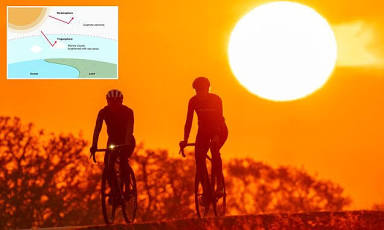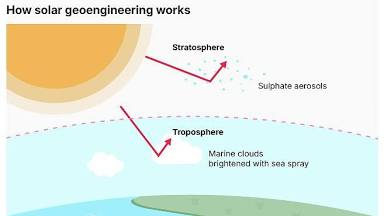
The UK Government is poised to approve groundbreaking outdoor experiments aimed at dimming sunlight to combat global warming, with official announcements expected within weeks.
These geoengineering trials—potentially including stratospheric aerosol injection and cloud brightening—are part of a growing scientific effort to develop emergency interventions to prevent catastrophic climate tipping points.
The Advanced Research and Invention Agency (Aria), the Government’s cutting-edge funding body, has allocated £50 million to support these initiatives.
Details of selected projects and their proposed timelines are due to be revealed shortly.
“Small, Controlled Experiments” Prof Mark Symes, Programme Director at Aria, confirmed that the funding would support “small controlled outdoor experiments on particular approaches.”

“We’ll announce who we’re funding in the coming weeks,” he said.
“At that time, we’ll also clarify when and where any outdoor testing might take place.”
Prof Symes emphasized a commitment to safety and ethical responsibility.
“Every project is safe by design. We are focused on responsible research—especially in the field,” he explained.
“Strict conditions will govern experiment duration and reversibility, and we will not fund the release of any toxic substances.”

Geoengineering: Controversial but Increasingly Urgent Geoengineering remains controversial, with critics warning of potential unintended consequences and arguing it may distract from the urgent need to cut carbon emissions.
However, as carbon dioxide levels continue to rise, scientists warn that mitigation alone may not be enough.
One promising line of research is sunlight reflection methods—strategies designed to reflect a portion of the sun’s rays back into space.

These include stratospheric aerosol injection, where fine particles are dispersed into the upper atmosphere, and marine cloud brightening, which uses sea-salt particles to increase cloud reflectivity.
Lessons from Nature and Industry Real-world phenomena have already hinted at the potential effectiveness of such techniques.
Scientists have long observed that clouds above major shipping routes appear unusually bright—a result of pollution-induced reflectivity.
Ironically, when global shipping regulations cut sulphur dioxide emissions in 2020, researchers noted a sudden uptick in warming.
Prof Jim Haywood, an atmospheric scientist at the University of Exeter, said: “If you inject small particles into clouds, you can brighten them—hence reflecting more sunlight out to space.

Ship trails and volcanic eruptions, such as the 2014 Iceland event, have shown us this effect in action.”
Exploring Additional Avenues Other geoengineering proposals include cirrus cloud thinning, designed to let more heat escape Earth’s atmosphere.
Unlike low-altitude clouds, cirrus clouds trap heat, contributing to warming.
Dr Sebastian Eastham, Senior Lecturer in Sustainable Aviation at Imperial College London, pointed out that aircraft already influence atmospheric conditions.
“Sulphur in jet fuel emissions and aircraft contrails unintentionally modify clouds,” he noted.

“These effects suggest the possibility of intentionally manipulating cloud properties using current technology—but there are many complex questions to resolve before any large-scale deployment.”
Looking Ahead If initial trials prove successful, experts believe these technologies could be ready for broader use within a decade.
Alongside outdoor tests, Aria’s funding will also support climate modeling, laboratory research, real-time atmospheric monitoring, and public engagement efforts to explore the societal impact and ethical considerations of geoengineering.
A: Sun dimming refers to geoengineering methods like cloud brightening or aerosol injection to reflect sunlight and cool the planet.
Q: Is the UK really going to test sun dimming?A: Yes, small-scale field experiments are expected to be approved soon, funded by ARIA.
Q: Why is sun dimming controversial?
A: Critics argue it could have unintended climate effects and distract from emission cuts.